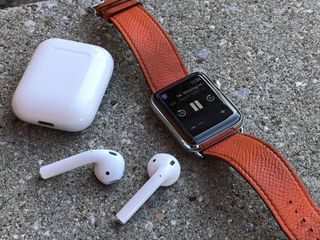AirPods and the future of ear computers

I can imagine, certainly not today or tomorrow, but one day, AirPods that contain a W5 or some other alphanumeric chipset, that slip into your ears and, through a combination of gestures and Siri — or better yet, SiriOS — can stream music, podcasts, and audio books straight from the clouds and into your ears.
Yeah, back in 2016, Apple deleted the 3.5mm audio jack and introduced AirPods, tiny little ear computers-in-the-making, disguised as wireless headphones. They've have gone on to become a breakout success and one of Apple's best products in years.
And I have a sneaky suspicion they're only just getting started.
AirPods 2
I've already written about all the rumors around AirPods 2 and the near future of the product in general. What I want to talk about now is a future for AirPods that's not quite so near. But, I very much hope is coming as absolutely soon as possible.
Ever more personal
A long time ago but not so far away, we had mainframes in our offices and we had to drive there to do everything. Then we got home PCs and, while they couldn't do everything the mainframes could do, at least not a first, they could do enough things to save us from having to drive all the way to the office, all the time.
Then we got phones, and same deal. Couldn't do everything a PC could do, but they could come with us everywhere and do enough to save us having to run back to our PCs to do everything.
Now we have watches, and again, they can't do as much as our phones but they can do a few things conveniently enough that we don't even have to reach for our phones if we're walking around the house or office, or running or swimming outside.
Master your iPhone in minutes
iMore offers spot-on advice and guidance from our team of experts, with decades of Apple device experience to lean on. Learn more with iMore!
Clocks went from town squares to living rooms to pockets to wrists, and so have too now have computers. But watches never went into our ears and computers, well, they already have.
W is for Wireless
Alongside AirPods, Apple introduced W1, a wireless chip designed by Johny Srouji's Platform Technologies org, the same team that makes the A-Series chipsets for iPhone and iPad, S-series for Apple Watch, T-Series for Macs, and the list, increasingly, goes on and on.

W1 is what lets AirPods not just pair so elegantly with iOS but sync so damn near perfectly with each other. They're literally tiny audio computers about which all the other sensors and components of the AirPods depend.
Apple has also made a W2 chip. Rather than second generation silicon for AirPods, it was made for the Apple Watch 3. It's job, rather than pairing and syncing, was to make wireless as fast and as power efficient as possible. Which was good, because 3 was when Apple introduced LTE.
W doesn't touch cellular though. At least not yet.
Apple, to the surprise of absolutely no one, has been working on cellular modems for a few years already. Just last week, Reuters reported that Apple had moved engineering responsibility for the technology from Dan Riccio's hardware organization to — you guessed it — Jony Srouji's silicon team.
That's for iPhone. Because, of course it's for iPhone. But Apple never innovates in a silo. What starts in iPhone will spread across the line.
Maybe, one day, even into AirPods.
iPods of future past
Once upon a time, Apple made iPods. But then came iPhone not really to obsolete them but to converge them. Steve Jobs even introduced it exactly that way — a widescreen iPod with touch controls, as well as a revolutionary phone and, totally burying the lede because few really appreciated it at the time, an internet communicator. It connected to iTunes like an iPod. It even had an app called iPod for the first few years until the name was switched to Music.

Traditional iPods lingered for a while but ultimately faded away, one by one.
But the iPhone, especially as it got big and bigger, wasn't really suited too be just an iPod, at least not for everyone all the time. So, when it was introduced and, increasingly as it evolved, Apple Watch began to be called the new iPod. Maybe more specifically, the new nano. It just came with its own strap, built-in.
It's apt, because with the addition of even limited LTE and, you knew this was coming — AirPods — Apple Watch has become the very model of a modern media iPod.
Rather than transferring from iTunes over a hard wire, though, it streams straight from Apple Music.
And this is all only 4 years later. Imagine another 4. Imagine 10.
The Apple Watch could become our iPhone. And what could become our Apple Watch. You guessed it — AirPods.
AirPods X
The type of technology needed to turn AirPods into full-on wearable computers is, right now, the stuff of sci-fi. But so were the current AirPods just a few years ago. And Apple Watch just a few years before that.
Getting a modem small enough to fit into something AirPod-like will take just the kind of miracle we've become all to accustomed to seeing from Johny Srouji's team. Getting a battery that can handle powering the modem and the mic and the speakers for any appreciable amount of time. Well, that'll take an even bigger — or rather, smaller — miracle.
But time and effort solves for so many things.
I can imagine, certainly not today or tomorrow, but one day, AirPods that contain a W5 or some other alphanumeric chipset, that slip into your ears and, through a combination of gestures and Siri — or better yet, SiriOS — can stream music, podcasts, and audio books straight from the clouds and into your ears.
And, the day or a few days after that, when they can not only send and read all your messages and mail, add all your reminders and appointments, but stream full-on audio augmented reality as well for everything from turn-by-turn mapping directions to interactive fitness workouts.
So, yeah, first like iPods. Then like JARVIS. Like HER.
Our phones are already external cybernetics. Our watches, wearable Borg tech. Our pods, the next most minimized, most proximate step. At least until things stop being so external.

Rene Ritchie is one of the most respected Apple analysts in the business, reaching a combined audience of over 40 million readers a month. His YouTube channel, Vector, has over 90 thousand subscribers and 14 million views and his podcasts, including Debug, have been downloaded over 20 million times. He also regularly co-hosts MacBreak Weekly for the TWiT network and co-hosted CES Live! and Talk Mobile. Based in Montreal, Rene is a former director of product marketing, web developer, and graphic designer. He's authored several books and appeared on numerous television and radio segments to discuss Apple and the technology industry. When not working, he likes to cook, grapple, and spend time with his friends and family.
Most Popular





